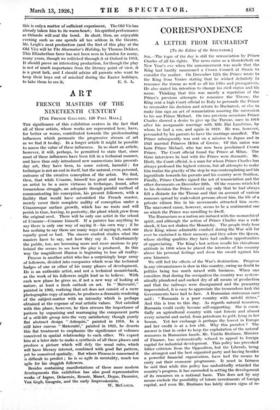ART
NINETEENTH CENTURY [TirE FRENCH GALLERY, 120 PALL MALL.]
Tax significance of this exhibition centres in the fact that all of these artists, whose works are represented here, have, for better or worse, contributed towards the predominating influences which permeate the progressive stream of art as we find it to-day. In a longer article it might be possible to assess the value of these influences. In so short an article, however, it will, perhaps, be permitted to state that, since most of these influences have been felt in a technical manner, and have thus only- introduced new mannerisms into present- day art, they have been, to some extent, harmful ; for technique is not an end in itself, but the natural, even personal, outcome of the creative conception of the artist. We find, then, that while Cezanne, himself too great and too sincere an artist to be a mere virtuoso in technique, found, after tremendous struggle, an adequate though painful method of communicating his conception, his present followers, with a facility that would have astonished the French master, merely cover their complete nullity of conception under a Channesque surface growth, which has no roots and will perish in time, leaving, to posterity, the plant which grew from the original seed. There will be only one artist in the school of Cezanne—Cezanne himself. If a painter has anything to say there is only one way of saying it—his own way ; if he has nothing to say there are many ways of saying it, each one equally good or bad. The sincere student studies what the masters have to say, not how they say it. Unfortunately the public, too, are becoming more and more anxious to pry behind the scenes to see how the play is produced. In this way the magnificent illusion is beginning to lose all reality.
Picasso is another artist who has a surprisingly large army of followers, divided into companies which wear the technical badges of one or other of his many phases of development. He is an authentic artist, and not a technical mountebank, as the work of his followers might lead us to believe. With each new phase he gives us, if not a new way of looking at nature, at least a fresh outlook on art. In " Maternite," painted in 1902, realizing that art does not consist of a mere photographic copy of nature, he produces a dramatic rendering of the subject-matter with an intensity which is perhaps obtained at the expense of real artistic values. Not satisfied with this phase, however, he then stresses the importance of pattern by organizing and rearranging the component parts of a still-life group into the very satisfactory though purely flat abstract design " Arlequin," painted in 1918. In a still later canvas " Maternite," painted in 1921, he deserts this flat treatment to emphasize the significance of volumes conceived in spatial relationship to each other. We expect him at a later date to make a synthesis of all these phases and produce a picture which will defy the usual rules, which will have literary interest, combined with good flat pattern, yet be conceived spatially. But where Picasso is concerned it is difficult to predict ; he is so agile in mentality, much too agile for his sluggish followers.
Besides containing manifestations of these more modern developments this exhibition has also good representative works of Ingres, Delacroix, Renoir, Manet, Degas, Daumier, Van Gogh, Gauguin, and the early Impressionists.
W. MeCAlsco.






























































 Previous page
Previous page